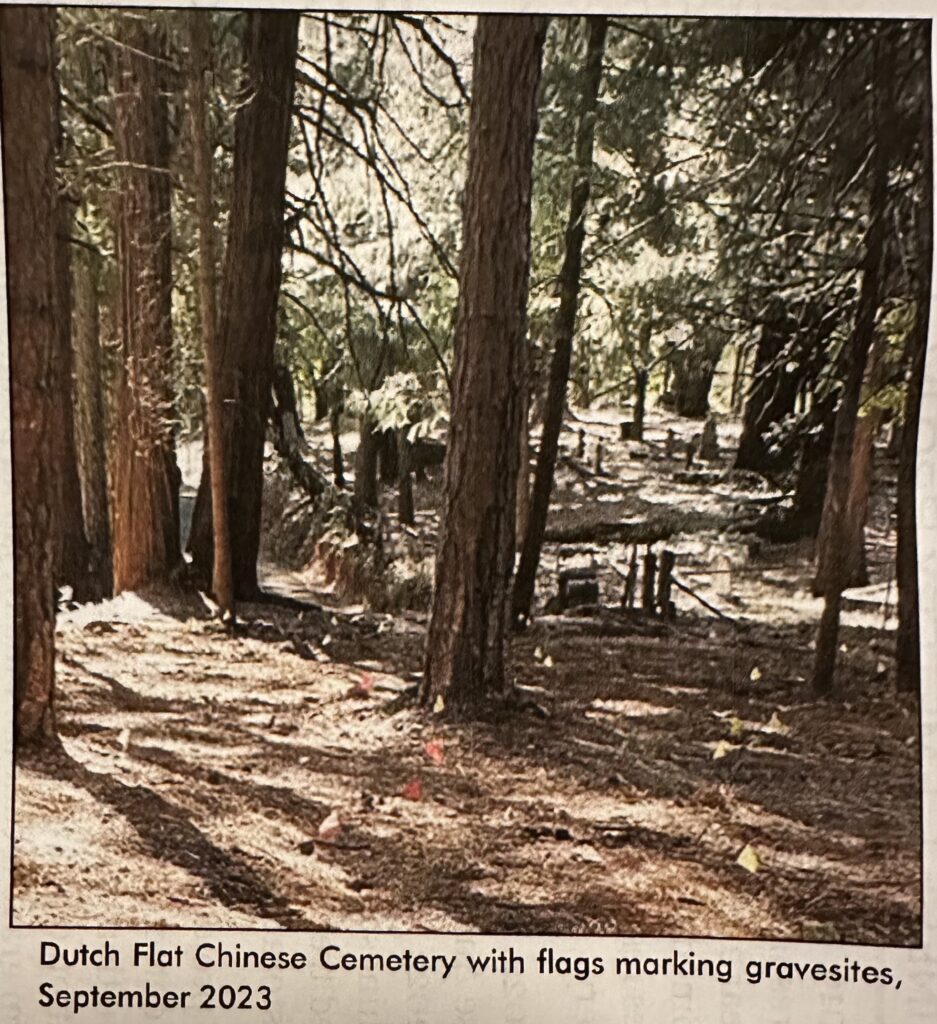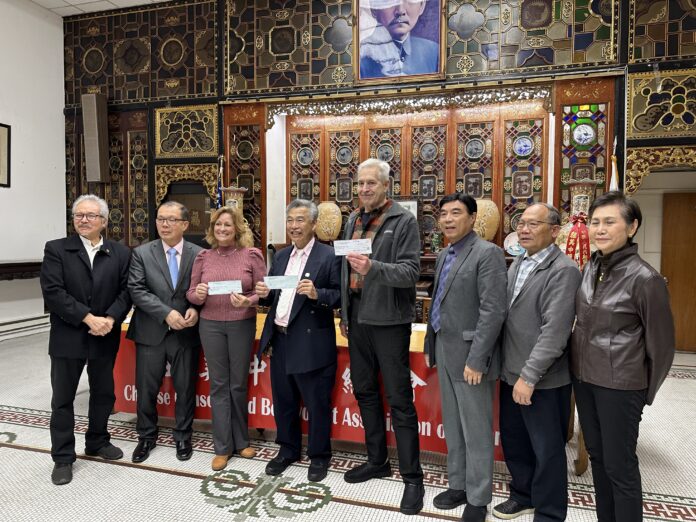by Akemi Tamanaha, Associate Editor
Chinese American community leaders hope to preserve history and honor the dead at an old cemetery in Dutch Flat, a small town in rural Northern California.
Community groups and activists in San Francisco’s Chinatown are now partnering with the Golden Drift Historical Society in Dutch Flat on the Chinese Ancestry Restoration Project (CARP). Part of the project will focus on restoring the Dutch Flat Chinese Cemetery.
During a recent news conference attended by AsAmNews, the Chinese Consolidated Benevolent Association presented Golden Drift Historical Society co-presidents Sarah and Thomas Fugate with checks totaling around $20,000 for restoration efforts.
“We’re trying to raise money to build a monument at Dutch Flat so that our future generations or future children can remember and also have it as a historic site,” Robert Wong, presiding president of the CCBA, said in his opening remarks at the press conference.
Chinese American History in Dutch Flat
Dutch Flat sits 30 miles northeast of Auburn in Placer County and 60 miles northeast of Sacramento. According to 2020 U.S. Census data, the small town has a population of only 183 people.
Some historians say that Dutch Flat was once home to one of the largest Chinese immigrant populations outside of San Francisco. Many Chinese immigrants moved to the area during the Gold Rush in the 1850s. They took jobs as railroad workers, miners and lumbermills
A website documenting Western Mining History suggested that the Chinese population reached 3,500 in 1853 in a town of just 6,000 people. The 3,500 estimate is not based on census data but on news articles from that time period.
In 1877, Dutch Flat Chinatown was burned and Chinese residents were forced to relocate a mile south of the town. Over time, the Chinese American population dwindled and eventually vanished.

Present Day
If you were to travel to Dutch Flat today, you’d find little physical evidence that a Chinatown ever existed. The Golden Drift Museum houses a few artifacts and photos, but, according to Thomas Fugate, an adobe storage shed is the only landmark that references the impact of the Chinese community.
The Golden Drift Historical Society has spent several years preserving the heritage and history of Dutch Flat. The Fugates are both grandchildren of immigrants. Sarah’s grandparents immigrated from England, and Thomas’s grandparents immigrated from the Netherlands.
In 2019, the society began focusing on uncovering and documenting the Chinese history of Dutch Flat. They reached out to several Chinese American activists and historians in the Bay Area to gather information.
Thomas said he saw the cemetery for the first time after receiving an invitation from community historian David Lei to attend a ceremony at the site on July 4. The cemetery was in bad shape, and there was nothing to indicate that it honored deceased Chinese Americans.
“And frankly, I was a little bit angry and disappointed that a cemetery and the people they’re in have been treated in such a disrespectful and offhand fashion, dismissive fashion,” Thomas said at the press conference.
Several other Chinese American activists from the Bay Area attended the July 4 incense ceremony. Video footage was documented and posted in a Youtube video.
Restoration Efforts
The goal of the restoration project (CARP) is to pay respects to the Chinese Americans who lived in Dutch Flat and teach others about their contributions.
The first step of the project was identifying gravesites at the cemetery. CARP used metal detectors to locate square nails that were used at burial to attach identifying information to wooden markers. Many of the graves were exhumed a few years later after the bodies decomposed so that the bones could be sent back to China by way of San Francisco for burial.
Researchers used ground-penetrating radar to confirm more than 300 grave locations and GPS technology to create a digital map of the gravesites.

The next step is to continue cleaning the area in preparation for further development. Project leaders have chosen Kate Bowers Landscape Design to draft plans for the public area of the cemetery. They include designs for a stone staircase entrance, gravel walkways, benches, memorials, and a burner for ceremonies.
Leadership hopes to have the project completed by July 4, 2024, in time for another pilgrimage and ceremony.
AsAmNews is published by the non-profit, Asian American Media Inc.
We’re now on BlueSky. You can now keep up with the latest AAPI news there and on Instagram, TikTok, Facebook, YouTube and X.
We are supported by generous donations from our readers and by such charitable foundations as the Robert Wood Johnson Foundation.
You can make your tax-deductible donations here via credit card, debit card, Apple Pay, Google Pay, PayPal and Venmo. Stock donations and donations via DAFs are also welcomed.


